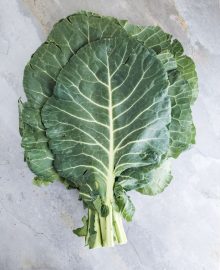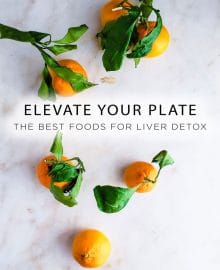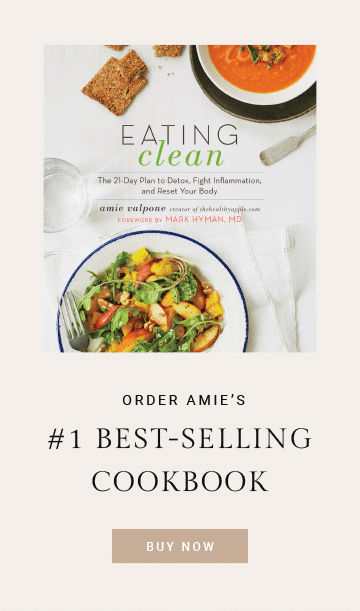
The Cooking Glossary

Here are a few of Amie’s favorite techniques for anti-inflammatory cooking that you’ll see in all of our recipes on this website and in Amie’s #1 best-selling cookbook, Eating Clean: The 21-Day Plan to Detox, Fight Inflammation, and Reset Your Body.
Bake // Like roasting, baking calls for an oven to cook food with dry heat.
Blanch // If you want to mellow the flavor of onions and garlic or take the raw “bite” out of veggies like broccoli, carrots, green beans, and so on, you can blanch them—or throw them into a large pot of salted boiling water for just a few seconds before transferring them immediately to a very cold ice water bath to stop the cooking process. The boiling water doesn’t cook the food, only softens it, and the cold water brings out the bright color of the veggie. You can use this method for veggies such as Brussels sprouts, broccoli, carrots, cauliflower, green beans, okra, and peas before freezing them; as well as for peaches and tomatoes to help peel them (just score the tomato bottoms with a little X before dropping them in the water). And don’t forget to add sea salt to that water. This will help bring out the natural flavor of the vegetables.
Blanching Nuts // For a quick way to peel almonds, boil a pot of water, add the almonds, and remove from heat for one minute. Then drain, rinse, and dry them. This allows the almond skin to separate from the actual almonds. Set them aside to cool, and then peel them with your forefinger and thumb by pinching them gently to slide the skin off the nuts. So easy! Allow almonds to dry on a baking sheet lined with a towel before storing. Place in a sealed container in the freezer until ready to use.
Caramelize // Sauté food over medium heat until its sugars turn golden brown. This brings out the natural sweetness of the food and also adds a deeper flavor. This method is most commonly used with onions, but most other vegetables benefit from caramelization, especially sweeter varieties like carrots and fennel.
Chiffonade // Cut food into ribbons. This usually refers to herbs like mint or basil. Lay the leaves on top of one another and roll them up like a little burrito, and then slice.
Chop // Cut food coarsely or finely (per recipe instructions). It doesn’t have to be in perfect pieces or a particular shape, but keeping everything relatively uniform will help it cook evenly.
Cube // Cut food into uniform pieces about 1/2- to 1-inch square or as specified in a recipe.
Dice // Cut food into uniform pieces about 1/4-inch square or as specified in a recipe.
Dredge // Coat food with breadcrumbs or finely ground nuts and seeds to achieve a crunchy outer texture after cooking. For example, you’d dredge sliced sweet potatoes before pan-frying them into sweet potato fries make zucchini fries.
Fold // Gently combine a light mixture with a heavier mixture, especially when baking or making batters. Place the heavier mixture in the bowl first, and then pour the lighter mixture on top. Use a large spoon or spatula to lift the heavier mixture up and over the lighter mixture and gently combine them together. This helps keep air in the mixture, which will add fluffiness to the final result.
Grill // Cook over the fire as direct heat. This is a quick-cooking method that lends smokiness to food. It’s perfect for veggies and, yes, even fruit!
Julienne // Cut food into thin, matchstick shapes.
Mince // Cut food into the smallest possible pieces.
Mis En Place // This is a term you’ll hear in almost any professional kitchen. Pronounced “meez in plahs,” it literally means “putting in place.” It’s how a chef describes her set up before she even begins cooking. It means all her ingredients are collected from the fridge and pantry, and all the tools she needs are at arm’s reach. By getting organized before you start cooking, you won’t be stressed or running around your kitchen to find something while your dinner burns in the oven!
Puree // Blend one or more ingredients with a food processor or blender to create a smooth texture.
Roast // Roasting involves a steady, even, dry heat that cooks food from the outside in, and usually results in a beautiful (and delicious) caramelized effect.
Slice // Cut food in a long, flat piece, or wedge. You can also use a mandolin for thin slices.
Sauté // A quick method of cooking food with olive or coconut oil. Usually done over high heat in a skillet. Stir the food as it cooks so it heats evenly, but not too much that you don’t get a fabulous golden sear.
Simmer // Low, steady cooking where the liquid in the pan should be gently bubbling. Use low or medium-low heat.
Soak // To submerge nuts, seeds, grains, or beans in water to activate enzymes, which makes them more easily digestible. No heat is required for soaking!
Steam // Food is cooked via the heat of steam instead of by direct contact with a pan or liquid. I often plop a steamer basket into my pot. Bring a large pot filled with one inch of water to a boil with a steamer basket above it. The food should not touch or sit in the water. Check to make sure the water doesn’t completely evaporate. This is a great way to keep nutrients in your veggies without losing them.
Stir-fry // A high-heat method of searing veggies. Use oil. Otherwise, the high temperatures will cause the natural sugars in the food to burn and stick to the pan.
Toast // Cook seeds, spices, or nuts on the stovetop in a dry skillet or in the oven on a baking sheet to release their natural oils and aromas. This enhances flavors and also reduces bitterness. Don’t let nuts or seeds sit when cooking on the stovetop. Shake or stir them over medium heat until fragrant. Be cautious; they burn quickly.
















